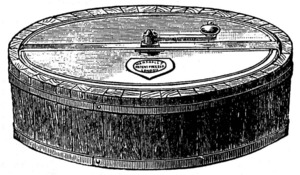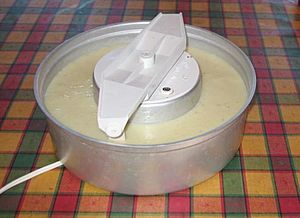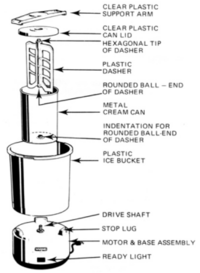Ice cream maker facts for kids
An ice cream maker is a special machine that helps you make small amounts of ice cream at home. These machines can mix the ingredients using a hand-crank or an electric motor. They also chill the mixture, either by being pre-cooled themselves or by freezing the ice cream mix as it churns.
An ice cream maker does two important things at once: it freezes the mixture and stirs (or churns) it. This stirring adds air to the ice cream and keeps the ice crystals super tiny, usually less than 50 micrometers (that's really small!). Because of this, most homemade ice creams are ready to eat right away. However, if you add alcohol to your ice cream, it might need a bit more chilling to become firm.
Contents
History of Ice Cream Makers

People have loved ice cream for a long time! Around 1832, a person named Augustus Jackson became famous for his ice cream recipes. He also found a better way to make ice cream by adding salt to the ice used for chilling.
In 1843, Nancy M. Johnson from Philadelphia received the very first U.S. patent for a small, hand-cranked ice cream freezer. Her machine was a cylinder made of pewter.
Later, during the Victorian era, a British cooking expert named Agnes Marshall was called the "Queen of Ices." She got a patent for her own ice cream machine. Her machine was amazing because it could freeze a whole pint of ice cream in just five minutes!
How Ice Cream Makers Work
Ice cream makers work by freezing your ice cream mix while also stirring it. This stirring is called "churning." It's important because it adds air to the mixture, making the ice cream light and fluffy. It also stops large ice crystals from forming, which keeps your ice cream smooth and creamy.
Some machines need to be pre-cooled before you start. Others have their own cooling system built in. After the ice cream is churned, most types are ready to enjoy right away. However, some simpler models might need you to put the ice cream back in the freezer for a little while to get the perfect firmness.
Types of Ice Cream Machines
Hand-Cranked Machines
The first hand-cranked ice cream maker was patented by Nancy Johnson in 1843. A few years later, in 1848, William Young started making these machines, calling them the "Johnson Patent Ice-Cream Freezer."
To make ice cream with a hand-cranked machine, you usually need ice and rock salt. You put the ice and salt around the container holding your ice cream mix. The salt makes the ice melt, and this melting process actually lowers the temperature even more. This happens because salt water freezes at a colder temperature than fresh water. The super-cold saltwater helps to slowly freeze your ice cream mixture, making it delicious.
Some small hand-cranked units have a special bowl with hollow walls filled with a cooling liquid. These bowls usually hold about 500 milliliters (about one pint). You freeze the bowl first, then pour in your ice cream mix. You place the bowl in your freezer and turn the paddles by hand every ten minutes or so. You keep doing this for a few hours until your ice cream is just right.
Electric Machines
Electric ice cream machines use an electric motor to stir the mixture. The main difference between them is how they keep the mixture cold.
Counter-Top Machines
These machines use a special double-walled bowl. Between the walls, there's a solution that freezes at a very low temperature. You need to put this bowl in your home freezer for up to 24 hours before you can use it. Once the bowl is frozen solid, you put it into the machine, add your ice cream mix, and turn it on. The paddles spin, stirring the mixture as it freezes against the cold bowl. After about 20 to 30 minutes, your ice cream is ready!
The good thing about these machines is that they are usually not too expensive. However, you can only make one batch of ice cream at a time because the bowl thaws as it works. If you want to make more, you need to refreeze the bowl or have extra bowls.
Small Freezer-Unit Machines
These ice cream makers are designed to sit right inside your freezer. They work a bit like a food processor moving slowly. Every few seconds, the paddles stir the mixture. This stops large ice crystals from forming. When the ice cream is frozen enough, the paddles stop spinning and lift up.
Since these machines cool the ice cream inside your freezer, it can take a bit longer for the ice cream to freeze. Some modern refrigerators even have a special spot or outlet for these machines. You don't need to pre-freeze anything with these. Some people feel the ice cream might not be as smooth because it freezes slower. There are also battery-operated versions that can go directly into the freezer.
Ice Cream Makers with Compressors
Ice cream makers with compressors have their own built-in cooling system, much like a refrigerator. This means you don't need to pre-freeze any bowls or put the machine in your freezer. You just add your ingredients, turn it on, and it starts chilling and churning right away!
These machines are known for making ice cream quickly. They can also make larger amounts, usually from 1 to 3 liters. They are fully automatic, so once you add your ingredients and set them up, the machine does all the work. This fast freezing method makes them very popular.
Built-in Freezer Machines

These are usually more expensive and larger machines. They have their own freezing system built right in, so you don't need to pre-chill any bowls. A few minutes after you turn on the cooling system, you can pour in your mixture and start the paddles. Just like with the counter-top models, your ice cream will be ready in about 20 to 30 minutes.
The best part about these machines is that they are always ready to go. You can make batch after batch of ice cream without any waiting time in between. However, some of these machines shouldn't be moved for several hours after being used, as moving them can upset the cooling system. This means they are often kept in one spot, which might not be practical for smaller kitchens.
Ice-Salt Coolant Electric Machines
This type of electric ice cream maker uses the old-fashioned ice and salt method for chilling, but with an electric motor. It has an outer tub where you put ice and salt. Inside, there's a canister that holds your ice cream mixture. An electric motor spins the inner canister and also moves a scraper that keeps the ice cream from sticking to the sides.
As the canister turns, the ice cream mixture freezes against its cold inner wall. The scraper constantly removes the frozen part and mixes it back into the rest of the liquid. The continuous turning and scraping makes the mixture thicker and thicker. With enough time, ice, and salt, you get smooth, "hard packed" ice cream.
See also
 In Spanish: Heladora para niños
In Spanish: Heladora para niños






